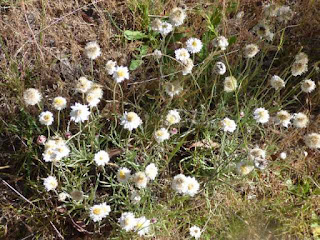ANPS feels the heat in Carwoola
16 members gathered on Captains Flat Rd, opposite Clydesdale Rd, for the first half of this double header.
It was not frigid as we climbed through the fence. For a change we went to the left inspecting the most Western part of the Reserve. Members of the family Asteraceae were very obvious from the start with a smallish patch of Leucochrysum albicans var tricolour encountered very soon after starting.
Here is a shot of a much larger colony found later in the walk.
Some specimens of Brachyscome aculeata (normally found in the higher areas) were also identified,
and swathes of Xerochrysum viscosum provided a nice touch of yellow.
Purple was offered by both Brachyscome rigidiula and Calotis scabiosi
Most of the members of the family Fabaceae seemed to grown beyond the flowering stage. Occasional blossom was noted on Bossiaea buxifolia and Daviesia genistifolia. Several Acacias were identified, but the only species flowering was A. mearnsii. One magnificent specimen
filled the air with perfume, but despite this enticement few invertebrates, and no honeyeaters were observed utilising this resource. Other flowering species included Viola betonicifolia
and a very nice Eryngium ovinum (Blue Devil)
and a very nice Eryngium ovinum (Blue Devil)
and a close up
There were many butterflies, mainly Common Brown and Australian Painted Lady.
(an out of focus image but it does shown the white areas, not on the Brown).
A small spider had chosen to wander on Jo's thumb!
A few members then retreated for various reasons and the rest of us headed to Cuumbeun Nature Reserve. Here we found a member of the NSW Parks Service about to enter the Reserve to spray some St Johns Wort: a very useful public service! He took a pause to show us the nest of a Honeyeater - most likely White-eared Honeyeater - complete with three nestlings - near the gate.
It was soon apparent that the 10 days of warm to very hot weather since my reconnaissance had caused many of the plants -notably the Dillwynnia spps - here to have finished flowering. It was also rather warm, and those species in the few shady shady spots got particular attention. Wahlenbergia, notably W. communis and W. stricta were common. A few plants of Gompholobium huegelii were found, but only one open flower was noticed (the image is from the earlier recce).
Dianella revoluta was flowering here and there,
while specimens of Styphelia triandra and Stypandra glauca were also seen, with no flowers, but distinctive leaves.
Dianella revoluta was flowering here and there,
At the lunch stop (in the shade, reached after a very hot walk up the rocky hill) Bossiaea buxifolia was found to be flowering.
On the walk back some of the Bursaria spinosa was approaching flowering but very little of the Kunzea ericoides was in bud yet. This is the opposite situation to our property less than 10kms away.
96 plant species were recorded here. A very good outcome given the rather sub-optimal weather conditions which resulted in a rather early finish.
In the animal world, other than the nest referred to above, most interest came from Cicadas, with one found emerging from a pupal case
and an adult travelling on a sleeve.
A Cut moth larva in its abode was also interesting
























Comments
Martin